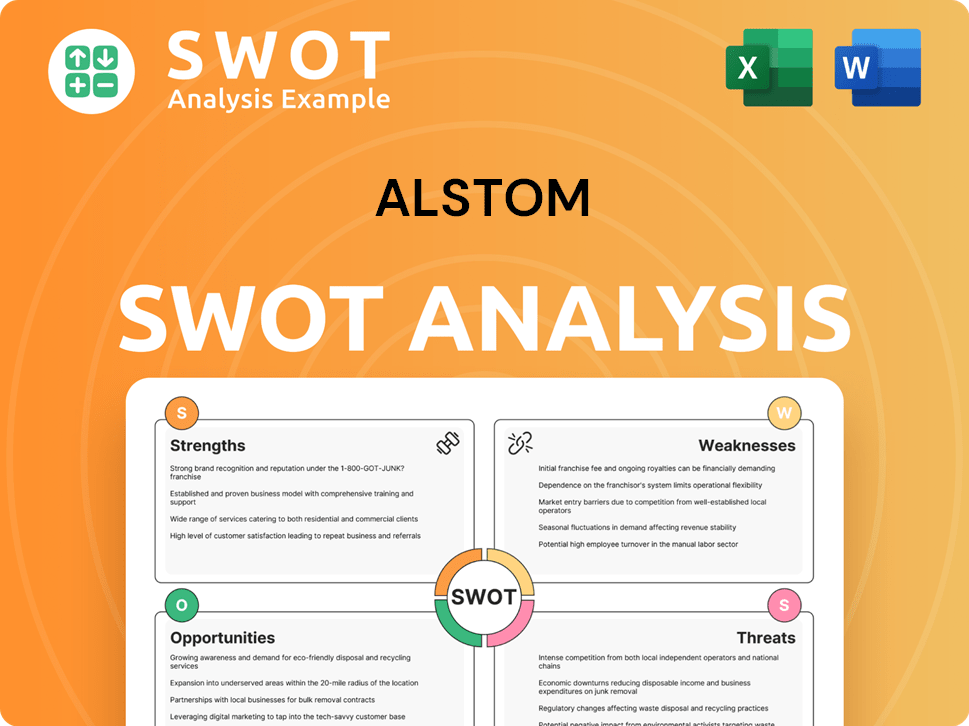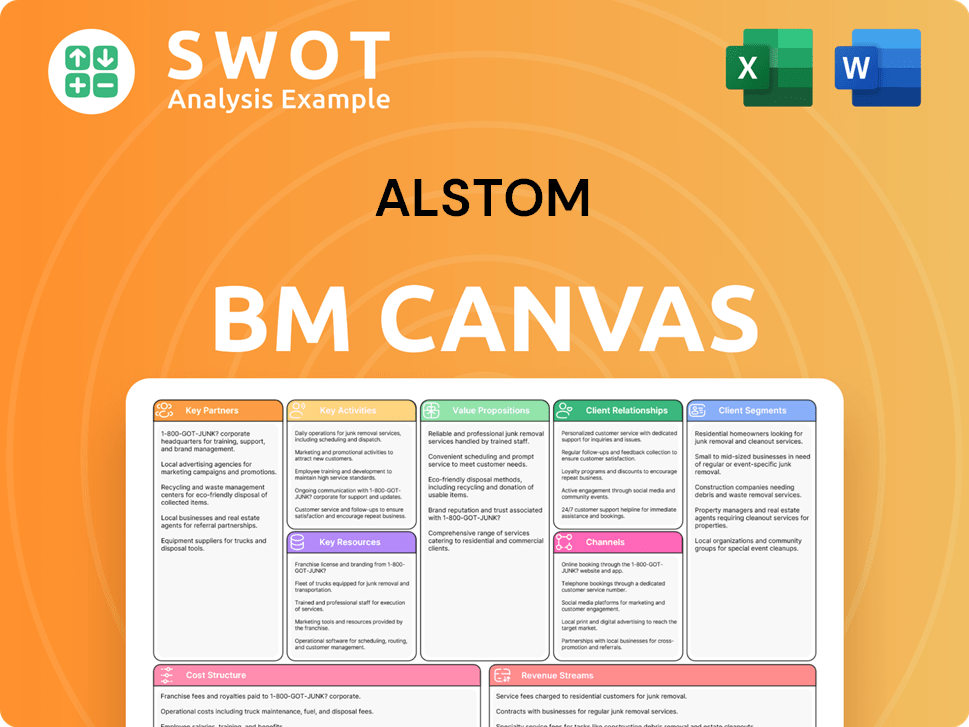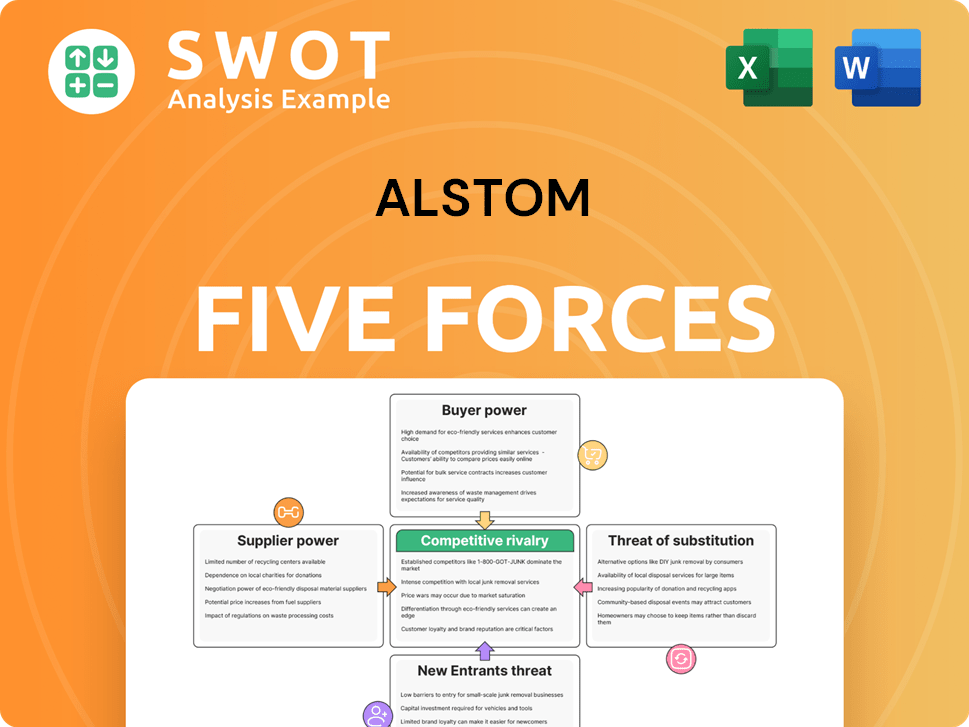Alstom Bundle
How Does Alstom Navigate the Cutthroat Rail Industry?
Alstom, a titan in sustainable mobility, is reshaping the transportation landscape with its innovative solutions. Its commitment to green initiatives and digital integration positions it as a leader in a rapidly evolving sector. Founded in 1928, Alstom has grown from a regional player to a global force, continually adapting to meet the demands of the modern world.

To truly understand Alstom's success, we must examine its Alstom SWOT Analysis, dissecting its competitive landscape and identifying its key rivals. This deep dive will illuminate Alstom's market share, business strategy, and financial performance within the global rolling stock market. We'll explore Alstom's competitive advantages and disadvantages, evaluating its position against competitors like Siemens and analyzing its strategies for sustainable transportation.
Where Does Alstom’ Stand in the Current Market?
Alstom holds a significant position in the global sustainable mobility sector, particularly within the railway equipment manufacturing and services industry. The company is a major player in the rolling stock, signaling, and services segments. Alstom’s strong market presence is demonstrated by its substantial order intake and sales figures, reflecting robust demand for its products and services. The company's focus on sustainable and digital solutions aligns with global trends, further solidifying its market position.
The core operations of Alstom involve the design, manufacturing, and servicing of a wide range of railway equipment and related systems. Its value proposition lies in providing comprehensive and integrated solutions that enhance the efficiency, safety, and sustainability of rail transport. Alstom offers a diverse portfolio including high-speed trains, metros, signaling systems, and digital mobility solutions. This comprehensive approach allows Alstom to cater to a broad spectrum of customer needs across various geographies.
Alstom's commitment to innovation and sustainability is evident through its investments in hydrogen-powered trains and advanced digital signaling systems. These initiatives not only enhance its product offerings but also position the company as a leader in environmentally friendly transportation solutions. With a focus on long-term value creation, Alstom continues to adapt its business strategy to meet evolving market demands and maintain a competitive edge. For more information on the company's target market, explore the Target Market of Alstom.
Alstom is consistently among the top global players in the railway equipment manufacturing and services industry. While specific market share figures for 2024-2025 are still emerging, the company maintains a strong position in key segments such as rolling stock, signaling, and services. Alstom’s competitive landscape is characterized by its ability to secure significant orders and maintain a substantial global presence.
Alstom's product portfolio includes high-speed trains (e.g., Avelia range), metros, monorails, and trams, alongside integrated systems, customized services, infrastructure, signaling, and digital mobility solutions. The company's diverse offerings cater to various customer needs, from public transport authorities to national railway operators. This comprehensive range ensures Alstom can meet diverse market demands effectively.
Alstom has a strong global presence, with operations spanning Europe, the Americas, Asia-Pacific, and the Middle East & Africa. Europe remains a core market, but the company strategically expands its footprint in emerging markets. This global reach enables Alstom to capitalize on growing urbanization and infrastructure development needs worldwide.
Alstom reported sales of €17.6 billion in fiscal year 2023/24. The company's financial performance reflects its substantial scale and robust demand for its products and services. Alstom's financial health supports its ability to invest in innovation and maintain a competitive edge in the market. The order intake for the fiscal year 2023/24 was €16.9 billion.
Alstom's competitive advantages include its extensive product portfolio, global presence, and focus on innovation and sustainability. These factors enable the company to meet diverse customer needs. However, disadvantages may include intense competition from other major players and the cyclical nature of infrastructure projects.
- Alstom's main rivals in the rail industry include Siemens Mobility, and CRRC.
- Alstom's position in the global rolling stock market is strong, with a significant market share in Europe and Asia.
- Alstom's competitive analysis in the North American market shows a growing presence, driven by infrastructure investments.
- Alstom's strategies for sustainable transportation involve investments in hydrogen-powered trains and digital signaling systems.
Alstom SWOT Analysis
- Complete SWOT Breakdown
- Fully Customizable
- Editable in Excel & Word
- Professional Formatting
- Investor-Ready Format

Who Are the Main Competitors Challenging Alstom?
The Alstom competitive landscape is shaped by a global market characterized by intense competition among established multinational corporations and innovative players. The company faces significant challenges in various segments, including high-speed trains, regional trains, and signaling systems. Understanding its key competitors is crucial for assessing its market position and strategic direction.
Alstom's ability to maintain and grow its market share depends on its response to competitive pressures, technological advancements, and evolving customer demands. The industry is dynamic, with ongoing consolidation, strategic alliances, and the emergence of new technologies that could reshape the competitive environment. Analyzing the strengths and weaknesses of its rivals provides insights into Alstom's strategic opportunities and potential vulnerabilities.
Alstom's key competitors include several major players in the rail industry.
Siemens Mobility, a division of Siemens AG, is a major competitor across multiple segments, especially in high-speed and regional trains, and signaling systems. Siemens often competes on technological innovation and its extensive global service network. Both companies are actively developing digital signaling solutions.
CRRC Corporation Limited, a Chinese state-owned rolling stock manufacturer, is the world's largest by revenue. Its immense scale, cost-effectiveness, and aggressive international expansion pose a significant competitive threat. CRRC's production capacity and competitive pricing can impact Alstom's market share in various regions.
Hitachi Rail, part of the Japanese Hitachi Group, is strong in high-speed rail, metro systems, and signaling. It has a growing presence in Europe and North America through strategic acquisitions. Hitachi's focus on integrated solutions and digital technologies directly challenges Alstom's offerings.
Stadler Rail AG specializes in regional trains and trams, offering another competitive dynamic. Stadler Rail AG is a Swiss company that designs and manufactures rail vehicles. As of 2024, Stadler Rail has a significant presence in the European market.
CAF is a Spanish manufacturer of rolling stock, contributing to the competitive landscape. CAF is a global company with a strong presence in the rail industry.
The rail industry is subject to mergers and alliances, such as the proposed merger between Alstom and Siemens' rail businesses in 2019, which was blocked. New entrants focusing on autonomous transport systems or hyperloop technologies could disrupt the traditional competitive landscape. Analyzing Alstom's competitive landscape involves understanding these dynamics.
- Market Share: Alstom, Siemens Mobility, and CRRC are major players in the global rail market, with varying market shares across different segments and regions.
- Technological Innovation: Companies invest heavily in R&D to develop advanced technologies, such as digital signaling, autonomous trains, and sustainable solutions.
- Geopolitical Factors: Trade policies, regulatory requirements, and geopolitical tensions influence market access and competition.
- Financial Performance: The financial health of competitors impacts their ability to invest in new projects, offer competitive pricing, and pursue acquisitions.
- Sustainability: The increasing focus on sustainable transportation solutions is driving competition in areas like electric trains and energy-efficient systems.
Alstom PESTLE Analysis
- Covers All 6 PESTLE Categories
- No Research Needed – Save Hours of Work
- Built by Experts, Trusted by Consultants
- Instant Download, Ready to Use
- 100% Editable, Fully Customizable

What Gives Alstom a Competitive Edge Over Its Rivals?
The Brief History of Alstom reveals a company built on technological prowess, a strong brand, and a comprehensive portfolio. Alstom's competitive advantages are rooted in its advanced technologies, extensive intellectual property, and a global presence. These factors enable it to secure a leading position in the rail industry.
Alstom's success is also driven by its ability to offer integrated solutions, encompassing rolling stock, infrastructure, signaling, and services. This end-to-end capability simplifies project management for clients, providing a competitive edge. The company's global footprint and supply chain contribute to cost efficiencies, supporting competitive pricing and robust after-sales support.
Alstom's competitive landscape is shaped by its technological expertise, brand equity, and integrated solutions. The company's strategic focus on innovation and sustainable mobility solutions, such as hydrogen trains, further strengthens its market position. Alstom's financial performance and strategic moves reflect its ability to adapt and maintain its competitive edge in a dynamic industry.
Alstom's technological capabilities, particularly in high-speed rail and metro systems, are a key advantage. The Avelia range of high-speed trains exemplifies its expertise in aerodynamics and energy efficiency. Alstom invests heavily in research and development, holding numerous patents that provide a barrier to entry for competitors.
Alstom's long-standing reputation for reliability and innovation has built strong brand recognition. This often translates into preferred partner status for major public transport projects. The company's focus on customer satisfaction and continuous improvement fosters long-term relationships.
Offering integrated systems, including rolling stock, infrastructure, and signaling, provides a significant advantage. This end-to-end capability simplifies project management and ensures seamless integration. This approach allows Alstom to provide holistic solutions, meeting diverse client needs.
Alstom's global manufacturing footprint and extensive supply chain enable cost efficiencies. This contributes to competitive pricing and widespread distribution. The company's service networks ensure strong after-sales support, fostering long-term customer relationships.
Alstom's competitive advantages include technological leadership, brand equity, integrated solutions, and a global manufacturing footprint. These strengths are crucial for maintaining its market share in the face of competition. In 2024, Alstom's order intake reached approximately €23.1 billion, demonstrating strong demand for its products and services. The company's focus on innovation, such as the development of hydrogen trains, positions it well for future growth.
- Technological Innovation: Continuous investment in R&D, including digital signaling and sustainable mobility.
- Strong Brand: A reputation built over decades of successful project deliveries worldwide.
- Integrated Solutions: Offering end-to-end capabilities, simplifying project management for clients.
- Global Presence: A widespread distribution and service network ensuring strong after-sales support.
Alstom Business Model Canvas
- Complete 9-Block Business Model Canvas
- Effortlessly Communicate Your Business Strategy
- Investor-Ready BMC Format
- 100% Editable and Customizable
- Clear and Structured Layout

What Industry Trends Are Reshaping Alstom’s Competitive Landscape?
The competitive landscape for Alstom is shaped by dynamic industry trends and evolving market conditions. The company faces both challenges and opportunities in the sustainable mobility sector, heavily influenced by global climate change concerns and the increasing demand for eco-friendly transportation solutions. This necessitates a strategic focus on innovation, particularly in areas like hydrogen-powered trains and energy-efficient rolling stock to maintain and improve its market position. The company's Owners & Shareholders of Alstom are key to its success.
Alstom's industry position is further impacted by digitalization and urbanization. Digital signaling, predictive maintenance, and autonomous train operations are becoming increasingly important, offering Alstom a chance to leverage its digital mobility solutions. Urbanization also drives demand for expanded public transport, especially in emerging markets, creating growth prospects for metro and tram systems. However, intense competition and geopolitical tensions can affect supply chains and market access, which could impact Alstom's financial performance and its ability to secure new projects.
The sustainable mobility industry is experiencing a surge in demand for eco-friendly transportation. Digitalization, including digital signaling and autonomous operations, is transforming the sector. Urbanization continues to drive the need for expanded public transport infrastructure, particularly in emerging markets.
Intense competition, especially from state-backed enterprises, puts pressure on margins. Geopolitical tensions and protectionist policies can disrupt global supply chains. Rapid technological advancements by new entrants, like hyperloop, could potentially disrupt traditional rail transport models.
Emerging markets with growing urban populations and underdeveloped rail networks offer significant growth prospects. Innovations in battery and hydrogen fuel cell technologies for trains provide avenues for leadership in sustainable transport. Strategic partnerships and acquisitions can strengthen market position.
The global rail transport market is expected to reach $278 billion by 2028, growing at a CAGR of 3.8% from 2021. Alstom's focus on sustainable solutions and digital technologies positions it well to capitalize on these trends. The company's strategy includes investments in R&D, strategic partnerships, and acquisitions to enhance its competitive edge.
Alstom is focusing on strategic initiatives to maintain its competitive edge. These include investments in research and development, particularly in advanced materials and digital solutions. The company is also pursuing strategic partnerships and acquisitions to expand its market presence and technological capabilities.
- Investment in sustainable mobility solutions, such as hydrogen-powered trains.
- Development of digital mobility solutions, including advanced signaling and predictive maintenance systems.
- Expansion into emerging markets with high-growth potential.
- Strategic partnerships to enhance technological capabilities and market access.
Alstom Porter's Five Forces Analysis
- Covers All 5 Competitive Forces in Detail
- Structured for Consultants, Students, and Founders
- 100% Editable in Microsoft Word & Excel
- Instant Digital Download – Use Immediately
- Compatible with Mac & PC – Fully Unlocked

Related Blogs
- What are Mission Vision & Core Values of Alstom Company?
- What is Growth Strategy and Future Prospects of Alstom Company?
- How Does Alstom Company Work?
- What is Sales and Marketing Strategy of Alstom Company?
- What is Brief History of Alstom Company?
- Who Owns Alstom Company?
- What is Customer Demographics and Target Market of Alstom Company?
Disclaimer
All information, articles, and product details provided on this website are for general informational and educational purposes only. We do not claim any ownership over, nor do we intend to infringe upon, any trademarks, copyrights, logos, brand names, or other intellectual property mentioned or depicted on this site. Such intellectual property remains the property of its respective owners, and any references here are made solely for identification or informational purposes, without implying any affiliation, endorsement, or partnership.
We make no representations or warranties, express or implied, regarding the accuracy, completeness, or suitability of any content or products presented. Nothing on this website should be construed as legal, tax, investment, financial, medical, or other professional advice. In addition, no part of this site—including articles or product references—constitutes a solicitation, recommendation, endorsement, advertisement, or offer to buy or sell any securities, franchises, or other financial instruments, particularly in jurisdictions where such activity would be unlawful.
All content is of a general nature and may not address the specific circumstances of any individual or entity. It is not a substitute for professional advice or services. Any actions you take based on the information provided here are strictly at your own risk. You accept full responsibility for any decisions or outcomes arising from your use of this website and agree to release us from any liability in connection with your use of, or reliance upon, the content or products found herein.